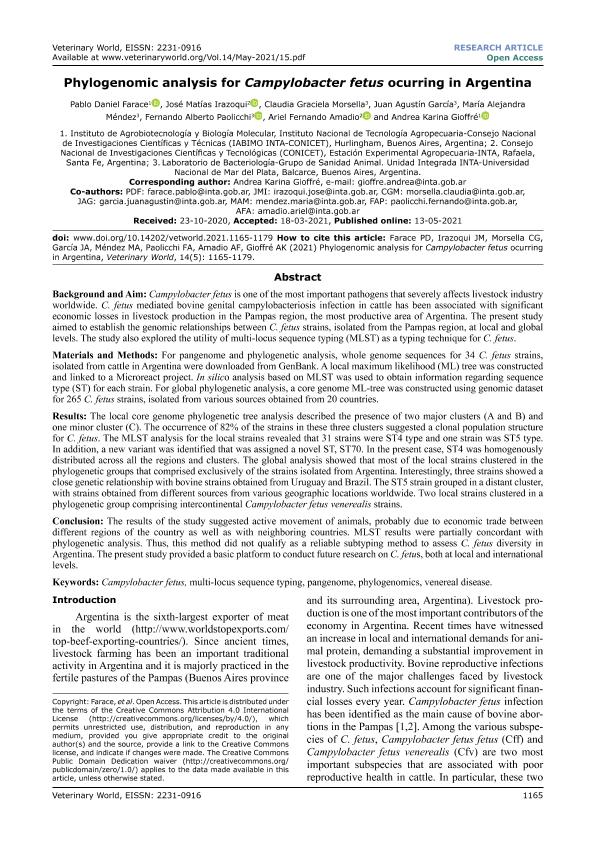Mostrar el registro sencillo del ítem
dc.contributor.author
Farace, Pablo Daniel

dc.contributor.author
Irazoqui, José Matías

dc.contributor.author
Morsella, Claudia Graciela
dc.contributor.author
García, Juan Agustín

dc.contributor.author
Méndez, Maria Alejandra

dc.contributor.author
Paolicchi, Fernando Alberto

dc.contributor.author
Amadio, Ariel Fernando

dc.contributor.author
Gioffré, Andrea Karina

dc.date.available
2022-12-30T00:01:31Z
dc.date.issued
2021-05
dc.identifier.citation
Farace, Pablo Daniel; Irazoqui, José Matías; Morsella, Claudia Graciela; García, Juan Agustín; Méndez, Maria Alejandra; et al.; Phylogenomic analysis for Campylobacter fetus ocurring in Argentina; Veterinary World; Veterinary World; 14; 5; 5-2021; 1165-1179
dc.identifier.issn
0972-8988
dc.identifier.uri
http://hdl.handle.net/11336/182865
dc.description.abstract
Background and Aim: Campylobacter fetus is one of the most important pathogens that severely affects livestock industry worldwide. C. fetus mediated bovine genital campylobacteriosis infection in cattle has been associated with significant economic losses in livestock production in the Pampas region, the most productive area of Argentina. The present study aimed to establish the genomic relationships between C. fetus strains, isolated from the Pampas region, at local and global levels. The study also explored the utility of multi‐locus sequence typing (MLST) as a typing technique for C. fetus. Materials and Methods: For pangenome and phylogenetic analysis, whole genome sequences for 34 C. fetus strains, isolated from cattle in Argentina were downloaded from GenBank. A local maximum likelihood (ML) tree was constructed and linked to a Microreact project. In silico analysis based on MLST was used to obtain information regarding sequence type (ST) for each strain. For global phylogenetic analysis, a core genome ML‐tree was constructed using genomic dataset for 265 C. fetus strains, isolated from various sources obtained from 20 countries. Results: The local core genome phylogenetic tree analysis described the presence of two major clusters (A and B) and one minor cluster (C). The occurrence of 82% of the strains in these three clusters suggested a clonal population structure for C. fetus. The MLST analysis for the local strains revealed that 31 strains were ST4 type and one strain was ST5 type. In addition, a new variant was identified that was assigned a novel ST, ST70. In the present case, ST4 was homogenously distributed across all the regions and clusters. The global analysis showed that most of the local strains clustered in the phylogenetic groups that comprised exclusively of the strains isolated from Argentina. Interestingly, three strains showed a close genetic relationship with bovine strains obtained from Uruguay and Brazil. The ST5 strain grouped in a distant cluster, with strains obtained from different sources from various geographic locations worldwide. Two local strains clustered in a phylogenetic group comprising intercontinental Campylobacter fetus venerealis strains. Conclusion: The results of the study suggested active movement of animals, probably due to economic trade between different regions of the country as well as with neighboring countries. MLST results were partially concordant with phylogenetic analysis. Thus, this method did not qualify as a reliable subtyping method to assess C. fetus diversity in Argentina. The present study provided a basic platform to conduct future research on C. fetus, both at local and international levels.
dc.format
application/pdf
dc.language.iso
eng
dc.publisher
Veterinary World
dc.rights
info:eu-repo/semantics/openAccess
dc.rights.uri
https://creativecommons.org/licenses/by-nc-sa/2.5/ar/
dc.subject
CAMPYLOBACTER FETUS
dc.subject
MULTI‐LOCUS SEQUENCE TYPING
dc.subject
PANGENOME
dc.subject
PHYLOGENOMICS
dc.subject
VENEREAL DISEASE
dc.subject.classification
Genética y Herencia

dc.subject.classification
Ciencias Biológicas

dc.subject.classification
CIENCIAS NATURALES Y EXACTAS

dc.title
Phylogenomic analysis for Campylobacter fetus ocurring in Argentina
dc.type
info:eu-repo/semantics/article
dc.type
info:ar-repo/semantics/artículo
dc.type
info:eu-repo/semantics/publishedVersion
dc.date.updated
2022-09-06T19:59:10Z
dc.identifier.eissn
2231-0916
dc.journal.volume
14
dc.journal.number
5
dc.journal.pagination
1165-1179
dc.journal.pais
India

dc.description.fil
Fil: Farace, Pablo Daniel. Instituto Nacional de Tecnología Agropecuaria. Centro de Investigación En Ciencias Veterinarias y Agronómicas. Instituto de Agrobiotecnología y Biología Molecular. Consejo Nacional de Investigaciones Científicas y Técnicas. Oficina de Coordinación Administrativa Parque Centenario. Instituto de Agrobiotecnología y Biología Molecular; Argentina
dc.description.fil
Fil: Irazoqui, José Matías. Consejo Nacional de Investigaciones Cientificas y Tecnicas. Centro Cientifico Tecnologico Conicet - Santa Fe. Instituto de Investigacion de la Cadena Lactea. - Instituto Nacional de Tecnologia Agropecuaria. Centro Regional Santa Fe. Estacion Experimental Agropecuaria Rafaela. Instituto de Investigacion de la Cadena Lactea.; Argentina
dc.description.fil
Fil: Morsella, Claudia Graciela. Instituto Nacional de Tecnología Agropecuaria. Centro Regional Buenos Aires Sur. Estación Experimental Agropecuaria Balcarce; Argentina
dc.description.fil
Fil: García, Juan Agustín. Instituto Nacional de Tecnología Agropecuaria. Centro Regional Buenos Aires Sur. Estación Experimental Agropecuaria Balcarce; Argentina
dc.description.fil
Fil: Méndez, Maria Alejandra. Instituto Nacional de Tecnología Agropecuaria. Centro Regional Buenos Aires Sur. Estación Experimental Agropecuaria Balcarce; Argentina
dc.description.fil
Fil: Paolicchi, Fernando Alberto. Instituto Nacional de Tecnología Agropecuaria. Centro Regional Buenos Aires Sur. Estación Experimental Agropecuaria Balcarce; Argentina
dc.description.fil
Fil: Amadio, Ariel Fernando. Consejo Nacional de Investigaciones Cientificas y Tecnicas. Centro Cientifico Tecnologico Conicet - Santa Fe. Instituto de Investigacion de la Cadena Lactea. - Instituto Nacional de Tecnologia Agropecuaria. Centro Regional Santa Fe. Estacion Experimental Agropecuaria Rafaela. Instituto de Investigacion de la Cadena Lactea.; Argentina
dc.description.fil
Fil: Gioffré, Andrea Karina. Instituto Nacional de Tecnología Agropecuaria. Centro de Investigación En Ciencias Veterinarias y Agronómicas. Instituto de Agrobiotecnología y Biología Molecular. Consejo Nacional de Investigaciones Científicas y Técnicas. Oficina de Coordinación Administrativa Parque Centenario. Instituto de Agrobiotecnología y Biología Molecular; Argentina
dc.journal.title
Veterinary World
dc.relation.alternativeid
info:eu-repo/semantics/altIdentifier/url/http://www.veterinaryworld.org/Vol.14/May-2021/15.html
dc.relation.alternativeid
info:eu-repo/semantics/altIdentifier/doi/http://dx.doi.org/10.14202/vetworld.2021.1165-1179
Archivos asociados
